Th Art Pablo Picasso Headed the Movement Which Rendered Familoar Objects as Geometric Shapes
The art movement known as cubism arose out of the need to ascertain and represent the then new mod reality. This new reality was complex and ambiguous, shaped by new inventions, philosophical speculation and cultural diversity. The new engineering and scientific discoveries were radically changing the footstep of life and the way society perceived the nature of things. Whereas in the by, life had been static, science and applied science were now forcing modern man to experience time, motion and space more than dynamically. All of a sudden he was thrust in a earth of expanding vision and horizons, of accelerated tempo and mobility and of fluctuating perspectives. Furthermore, the ambiguity and sense of uncertainty generated by this new rush of stimuli was interpreted by the theory of relativity that evolved through F. H. Bradley, Whitehead, Einstein, and the new mathematics. What these philosophical theoreticians suggested was that we live in a world of shifting perspectives, where the appearance of objects is in a constant flux depending on the point of view from which it is seen. Finally, the experience of reality was as well being altered by the cultural interactions taking place between the Due east and West, the primitive and the industrialized. In other words, each culture brought along with information technology a new, idiosyncratic manner of looking at things, and the interchange occurring betwixt cultures obscured the perception of truth. Relativity became everything.
The trouble facing the mod artist became how to formally draw this new dynamic vision of life. For the painter, specifically, the dilemma became representing the flux of time, motion and space in a medium that lent itself to the mere capture of the fleeting moment. Cubism was built-in every bit a response to this predicament, and it is no blow that the movement was a Parisian phenomenon, considering the city'southward artistic legacy and its magnetic power to concenter the almost gifted young artists and writers from all over the world. Paris offered them dandy art museums, a tradition of moral and artistic freedom, and an creative bohemia where they could live cheaply on the margin of bourgeois order.
Perchance we can say that Pablo Picasso'southward Les Demoiselles d'Avignon ushered in a revolutionary way of depicting reality. This landmark painting had broken all of the traditional rules that artists at the fourth dimension followed, especially the one that divers art as imitation rather than creation. Picasso had decided to plough his back on a fixed point of view and harmonious proportion, concepts that had been religiously good since the Renaissance. Instead, he replaced these with multiple perspectives and distortion. Furthermore, he incorporated into his painting references to primitive fine art, a practice that ran counter to the ceremonious adulation of the whole continuum of Western art. For most people, Les Demoiselles was a desecration of everything that had been held every bit sacred. Simply fortunately, Picasso's rebelliousness cleared the air for what was to come: a freedom to create rather than imitate and to construct a new pictorial linguistic communication.
Cubism was born out of the interaction and collaboration that occurred between Picasso and Georges Braque right after they met in 1907. When Braque saw Les Demoiselles for the first time, he went into a state of shock. However, many months after this initial meet and much reflection, Braque reconsidered his initial reaction and responded with Large Nude (1908), in which he follows Picasso's lead and combines several points of view in i image. Presently afterwards, an artistic partnership adult between the 2 artists that was to define the nature of painting for years to come. At start, Picasso was concerned with the formal and technical freedoms that African art and masks had inspired while Braque experimented with the revolutionary innovations in Les Demoiselles. Picasso's Dryad (1907) captures the tribal stance besides as the formal baloney and fibroid hatching and scoring of primitive art. Merely Braque would have a sobering vox in this artistic relationship. His function was to neutralize Picasso's artistic savagery by incorporating it into Paul Cezanne'southward more than conservative formal legacy of reducing reality to basic geometrical shapes that are conspicuously continued with one some other. Out of this artistic reconciliation, Analytical Cubism, the beginning phase in the evolution of Cubism, was born.
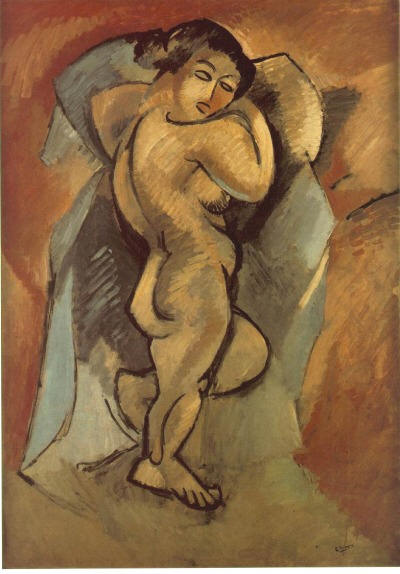
Large Nude (1908)
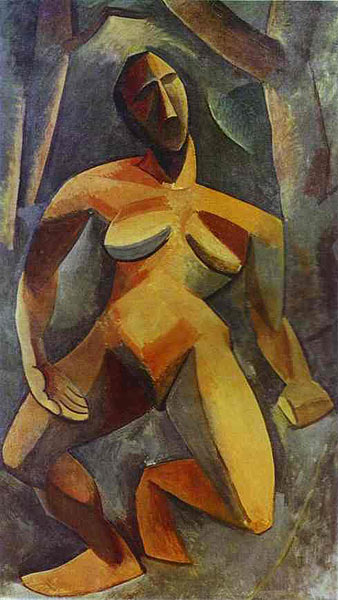
Dryad (1908)
In the outset of their creative partnership, Picasso and Braque had get consumed with Cezanne�s feeling for the �architecture� that underlies nature and with his argument that �everything in nature is based on the sphere, cone, and cylinder.� Cezanne�s piece of work also suggested to Picasso and Braque that art was neither an fake nor an illusion of reality, but, in effect, a new kind of reality, created through the means of a new �linguistic communication� of forms. For C�zanne, a film is of import in its own right, and thus, it must remain faithful to itself. Thus the aim of painting is not to pretend that the viewer is looking through a window, but to make the viewer aware of the picture surface itself equally well as the subject matter it depicts.
Picasso and Braque took both of these notions 1 step further. Whereas Cezanne believed that the written report of an object was the real solution to all of the painter's problems, Picasso and Braque had become totally absorbed past the problem of representing the complication of reality in art. Because they lived in an age which was very distinct from Cezanne'due south, their perception of reality was different. They believed that our cognition of things was composed of its multiple relations to each other and change their appearance according to the point of view from which we see them. Furthermore, they perceived the cubist object as the bespeak at which idea almost the object intersects our sense impressions and feelings nearly it.
Belittling Cubism: Mapping Reality
As its name implies, the paintings associated with the Analytical Cubism phase show evidence of a methodology through which Picasso and Braque used to "break down" the surface of the objects being represented into basic, geometrical shapes. Picasso's Woman with a Fan (1908) is a volumetric study of a adult female whose features are simplified into spheres and triangles and suggests a sculptor at work, equally indeed Picasso was. Information technology is C�zanne taken to the farthermost. Another painting that shows the difference in pictorial technique between the cubists and C�zanne is Houses at 50'Estaque (1908). Hither, Braque borrows the same colors and geometric shapes that C�zanne uses in his Mont Sainte-Victoire paintings. But here the similarity ends, for a panoramic, fixed view of the landscape is not enough for Braque. What Braque does is subordinate color in society to attain a geometric structure of overlapping, shifting, tilted cubes that seem to project out of and into the motion-picture show aeroplane, as though we were watching a three-D moving-picture show. The outcome that is created is non that of a single-point linear perspective, rather, that of a scene changing every bit it is observed from various positions. In other words, Braque was trying to record the process of seeing, and, in order to do so, he has constructed a composite of several unlike simultaneous views of the objects to exist viewed in one synthetic moment. By doing this, Braque transformed the canvass from being the static record of a fleeting moment to a more dynamic vision akin to moving pictures. The canvas, then, became similar a screen onto which images are projected.

Woman with a Fan (1908)
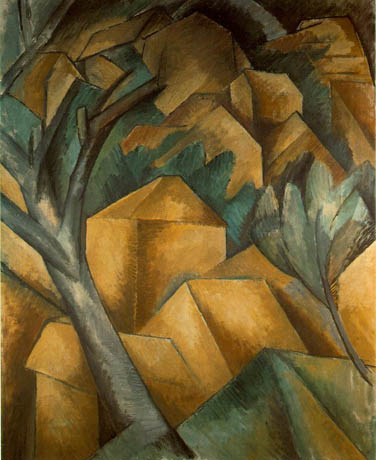
Houses at l'Estaque (1908)

Violin and Palette (1909).
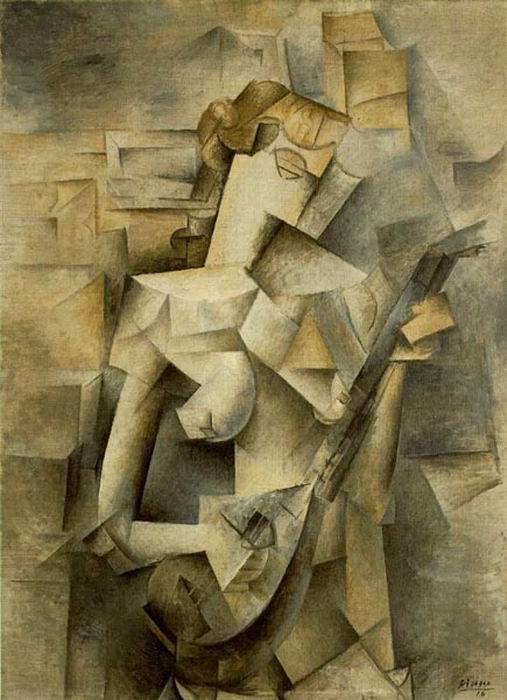
Girl with Mandolin (1910)
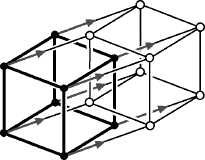
The Fourth Dimension
These new ideas well-nigh a reality that is in a constant state of constant flux injected the element of dubiety in Picasso and Braque�s ongoing debate well-nigh the nature of the artistic process. How does one, they asked themselves, capture the ethereal, shifting quality of reality, where object and environs become inseparable? How does one reconcile the intellectual and intuitive faculties when they appear and then antithetical? What so is the relationship betwixt the coherent artifice of traditional �realistic� art and the incoherent processes by which we experience our environment, between Renaissance perspective and multiple points of view as a consequence of the dispatch of the stride of modernistic life? Where does the spectator stand? and the object? The result of these rhetorical questions, the paintings of 1910-11 probe further and further into the nature of realistic illusions and gradually refine the balance in which the spectator was poised, between the internal world of the painting�s structure and the external world of its references to reality. Now Picasso and Braque�s concern shifted to creating a new artistic language that would limited the multiplicity and complexity of these relationships and, at the same time, suggest stability. What they jointly developed was a new kind of painting, one that emphasized pictorial configuration rather than motif, thus moving in the direction of abstraction. To attain this new pictorial structure, Picasso and Braque replaced the traditional perspective by a shallow infinite in which there is niggling altitude between figure, foreground and background. Consequently, the eye is not led back into an imaginary distance but is held on the painting�s surface, and yet, at the same time, is invited to feel three-dimensionality in a new way. The artist is now free to suspension apart the object into small facets or pieces and distribute them well-nigh the sail as the composition requires. The painter can testify the back, front or side of an object simultaneously. Art historians refer to this phase of cubism equally �facet cubism,� �high analytic cubism� and
By the cease of 1910, Picasso farther explores this new phase of analytical cubism in Portrait of Ambrose Vollard although he is still committed to the rendering of the particulars of his discipline matter. Picasso�s bang-up power as a caricaturist is demonstrated in this painting, in which a powerful floating bald head, the defining characteristic, emerges as the product of several combined viewpoints from the muted monochromes of an angular maze. In this painting the effigy of Picasso's famous art dealer has dissolved into the cubist grid, with only his facial construction, protruding jawbones, pug nose, the color and texture of ruddy flesh and light-brown pilus, bristles and mustache. Vollard is seated facing us; behind him is a tabular array, on which are a bottle, on his right, and a book, peradventure a ledger, on his left. Picasso has even included the handkerchief in Vollard�south pocket. The famous dealer is portrayed equally being very cerebral as he gazes downward at a rectangular shape, which judging from his expression of shrewd critical discernment may be a piece of work of art. The whole surface of the painting is a series of small, intersecting planes, whatever one of which can be interpreted as being both behind and in forepart of other, bordering planes.
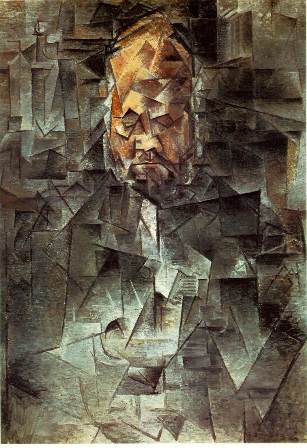
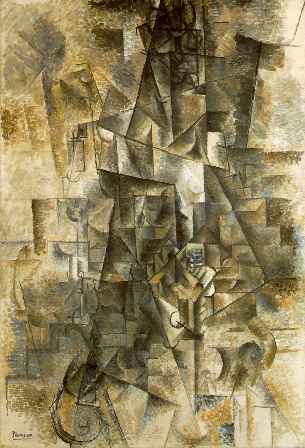
Portrait of Ambrose Vollard (1910) The Accordionist (1911)
This reductive, fragmenting process is taken fifty-fifty further in The Accordionist (1911), where the figure has been so fragmented that it is no longer credible what is being represented, and so the title purveys the inkling equally to the nature of its discipline affair. The triangular scaffolding grid provides the structure on which to suspend the about unrecognizable fragments of this musician. The only recognizable vestiges of the accordionist�due south instrument are the keys and bellows shown fragmented from multiple viewpoints, located center left of the painting. More than an analysis, this painting is an assembling of parts. The outcome of Braque and Picasso's experimentation was true liberation from the Renaissance' concept of conceiving the globe from the static point of view of geometrical perspective and of portraying painting as an human action of fake. This interruption with the past entitled artists to all kinds of new possibilities.
Picasso and Braque's experimentation with the very concept of constructing a work of art lead them into the final phase of cubism--constructed cubism. Equally its name implies, synthetic cubism worked on the premise of assembling out of separate parts new forms. What they were trying to recreate in this stage of cubism is how mod urban street life appears to the onlooker. Whereas in the analytical phase Picasso and Braque were deconstructing and so reassembling bits and pieces to advise objects equally seen from multiple angles, in this latter phase they were interested in superimposing fragments 1 on meridian of another to simulate walls plastered with posters too as stacked newspaper displays at kiosks. Furthermore, they no longer concerned themselves with the representation of space considering at present the emphasis was on digesting multiple layers of information and shapes. The end results were compositions that were simpler, brighter, and bolder accomplished through the post-obit techniques:
- bringing together familiar scraps and unfamiliar forms in club to requite shape to a particular sense of urban life
- exploring the private experiences associated with public spaces and urban recreation
- using the language of publicity and commerce in an ambiguous manner to advise a multiplicity of contradictory meanings, especially through puns
- capturing the new sense of simultaneity of diverse experiences-the fusion of objects, people, machines, noises, lite, smells, etc.
How was information technology that Picasso and Braque decided to change the manner that they were depicting reality? While Picasso preferred the more traditional subject affair of nudes and portraits, Braque oscillated to still lifes and landscapes. Nevertheless, information technology is effectually this time that Picasso and Braque began to paint similar twins, their work condign undistinguishable from one some other. Colour, texture, and linear structure are almost the same. Merely Braque, ever the pragmatist, nudged Picasso by reminding him that their work was becoming so abstruse that field of study matter was no longer recognizable. In lodge to bring painting back to reality, Braque introduced a new element to their work--visually realistic objects taken from popular culture. Fifty-fifty earlier this indicate in the evolution of cubism, Picasso had already pasted a small-scale piece of paper on the center of a drawing to make what was the first papier coll� or collage in 1908. As early as 1910, both artists had been incorporating words, letters and numbers into their paintings, and Braque, in detail, had used trompe-l'oeil wood-grain effects. This technique came naturally to Braque since he had been a house painter earlier becoming an artist.
By re-instating recognizable elements from everyday life into their paintings, Picasso and Braque were asking a very important rhetorical question well-nigh the very nature of art: What is more existent, art or reality? Through their farther exploration of this question, Picasso and Braque seemed to exist implying that they are both just equally existent for they can co-be on the same plane, the aforementioned canvas. All suddenly both of these artists introduced bits of observed nature onto the canvas, too equally products of mod industry: sail music, newspaper, playing cards and restaurant menus. As in music, Picasso and Braque were employing scraps of reality as counterpoints to the abstract structures created through paint. Once more, Picasso and Braque had revolutionized the world of art. This new phase in the development of cubism became known equally collage.
Picasso'southward kickoff collage is Still Life with Chair Caning (1911-12), on which he embeds a piece of oilcloth that simulates chair caning. What Picasso seems to be suggesting here is that at that place are many unlike levels of reality, for the oilcloth itself is a manufactured representation of some other craft--caning. Looking closely at this collage, it appears that the painted parts of the work depict a drinking glass in the middle, behind which lies a copy of the newspaper Le Journal (hence the letters JOU) and a white dirt piping. To the right are two lemon slices and a pocketknife, and beneath them what might be an oyster shell. The shadows or refractions from the glass lie across the oilcloth, and towards the bottom edge of the sheet a brown strip seems to stand for the front edge of the tabular array. Finally, the oval shape of the painting is �framed� by a slice of real rope. What Picasso has managed to practice here besides reminding u.s.a. that manufactured materials, words, and even fine art are all similar in that they are means of representing reality and that, furthermore, by including them all together he has challenged the traditional need that artists should strive for artistic unity. Thus their juxtaposition in the same picture makes the bespeak about the nature of language simply likewise blurs the distinction between them. Even the oval shape of the canvas signifies something else: the seat of a chair or the surface of the caf� tabular array on which the objects sit down. Since the French word for an easel moving-picture show is tableau, Picasso delights in the joke that his picture is a vertical tableau which is besides a horizontal table.
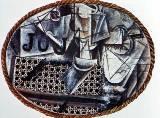
However Life with Chair Caning (1912)
Just as Picasso and Braque�s fine art had explored the philosophical ideas of Bradley, Whitehead, and Bergson, they now began to flirt with the inclusion of verbal and musical linguistic communication in their works. At the turn of the century, linguists in Europe and the U.s. had begun to wonder what language really was and how to describe it, leading to a new appreciation of the importance of structures and codes to linguistic meaning and the arbitrary adventitious nature of the manner language describes reality. These ideas became the basis of the study of signs known every bit semiotics. Although Picasso and Braque couldn�t take been more removed from these academic studies, their work of this menstruum, all the same, is a testament to their questioning the relationship betwixt fine art, language and representation.
Although it was Braque who invented the thought of collage, it was Picasso who outset executed it. All the same, Braque invented and executed the commencement papier coll�, a kind of collage consisting of papers that are glued onto the canvas. Braque�due south inclusion of paper seems to be coordinating to the improver of the oilcloth. Only Braque�south use of wallpaper does this and more. What Braque has discovered here is that in that location are prepare-made materials that simulate �woodness,� that do not have to be drawn or painted and that can exist cut up and manipulated, that are always the same no matter what the �light� in the motion-picture show, and that tin appear independently of the shape of the object of which they are meant to be a part. Braque has added the chemical element of materialism into painting. So instead of painting something onto the canvas, he just glued it on--whether it exist newspaper scraps, wallpaper, paper printed to resemble something else, advertisements, etc. Furthermore, Braque used all kinds of decorative painting techniques learned from his days equally a business firm painter. He incorporated combing, faux graining, and adding sawdust and sand for texture. Braque also added shadows with graphite and charcoal thereby mixing drawing and painting techniques. A case in betoken is Braque's Woman with a Guitar (1913) in which the artist assembles a woman playing a guitar from different layers of shapes, colors, and ready-made materials stacked to create her essence.

Woman with a Guitar (1913)
And then why were Picasso and Braque incorporating mundane materials such as oil cloth and wallpaper? Ane suggestion comes from a purported conversation between Picasso and his mistress Francois Gilot that took place many years afterwards:
We tried to get rid of trompe fifty�oeil to find a trompe l�esprit (deception of the mind/spirit). We didn�t whatever longer desire to fool the middle; we wanted to fool the mind. The canvass of newspaper was never used in order to make a newspaper. Information technology was used to get a canteen or something like that. It was never used literally but ever as an element displaced from its habitual definition at the bespeak of divergence and its new definition at the point of inflow. If a slice of newspaper can become a bottle, that gives us something to recollect well-nigh in connexion with both newspapers and bottles, too. The displaced object has its strangeness. And this strangeness was what we wanted to make people recall almost considering we were quite enlightened that our earth was becoming very strange and not exactly reassuring.
Collage and papier coll� gave Picasso and Braque the opportunity to pursue the estrangement as well as the diversity of modern life. Furthermore, introducing real objects into their paintings allowed them to remove the distinctions between what is existent and what is created past the creative person, betwixt art and mass-produced objects, and between painting, cartoon, and commercial art. Every bit Picasso himself said, �Art is a lie that helps united states sympathise the truth.�
While Picasso and Braque were experimenting, a coterie of artists were scrutinizing what these ii leaders were doing, came under their influence, exhibited together and ultimately were labeled as being cubists likewise. Adjacent to Picasso and Braque, Juan Gris was perhaps the most famous of this group. Equally a thing of fact, his work, which was from the start synthetic in nature, probably inspiring Picasso and Braque to bring back lite and colour into their canvases. His style can best exist described as having intensely colored geometric planes which combine with familiar collage components to create a tightly interlocked pictorial harmony.
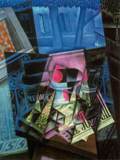
Still Life with Open Window (1915)
Another important cubist was Fernand Leger, whose contribution to the fine art motility was the commemoration of the new car age. Leger created his images of machine forms and robots from cylinders and cones, the basic edifice blocks of his piece of work. The ultimate effect of his work is a harmonious mechanical world where man happily participates.
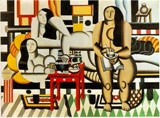
3 Women (1921)
Robert Delaunay was a cubist who steered away from the nonetheless life and the figure, embracing the architectural epitome of the Eiffel Belfry and the plane every bit the images of modernity. In his paintings, Delaunay was interested in capturing the whole dynamics of the new cult of the machine. In his Eiffel Tower paintings, Delaunay portrayed the tower equally it loomed over the city during structure, arising out of it like the new phoenix. In Homage to Bleriot, the artist celebrates the new dynamism of the new industrial age by painting vibrating discs of color that simulate plane propellers in motion.
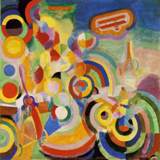
Homage to Bleriot (1913)
Source: https://www.mdc.edu/wolfson/academic/Artsletters/art_philosophy/humanities/cubism/cubism%20front2.htm
Post a Comment for "Th Art Pablo Picasso Headed the Movement Which Rendered Familoar Objects as Geometric Shapes"